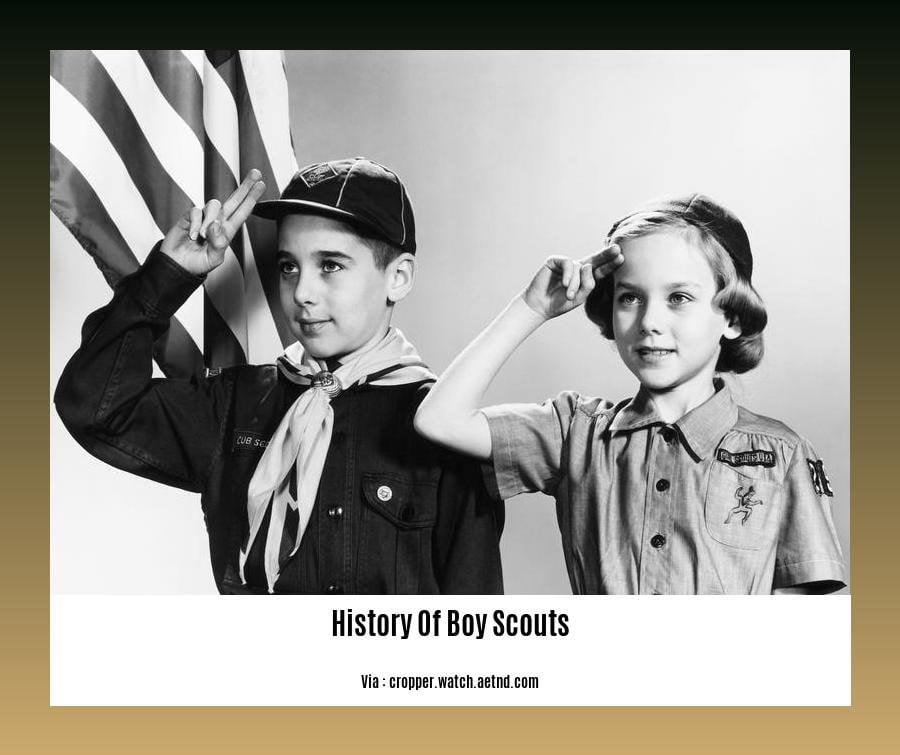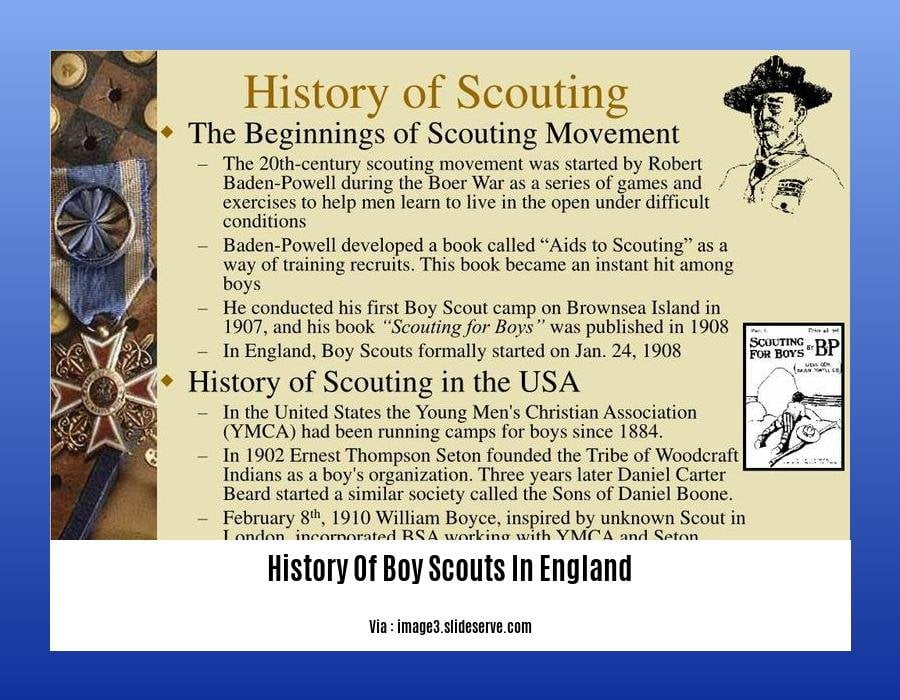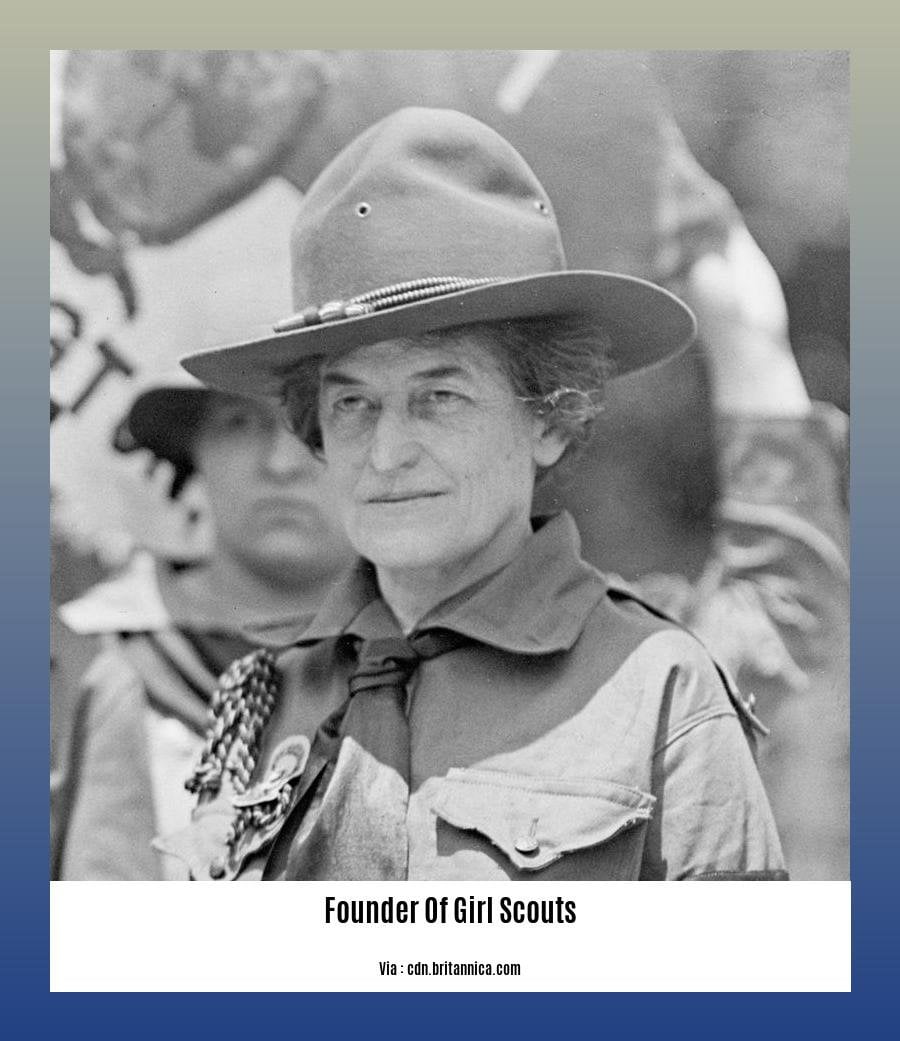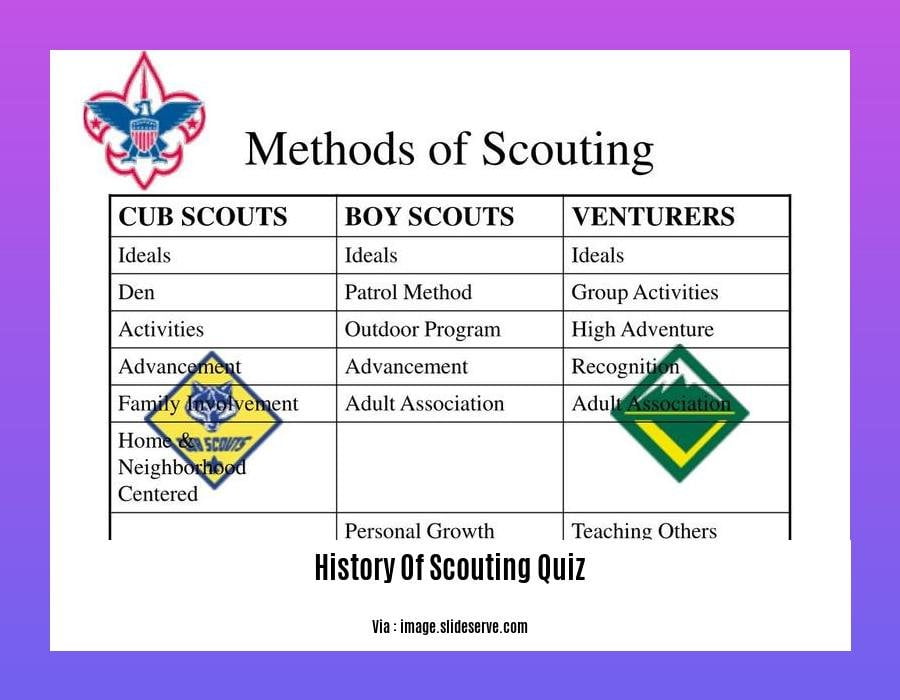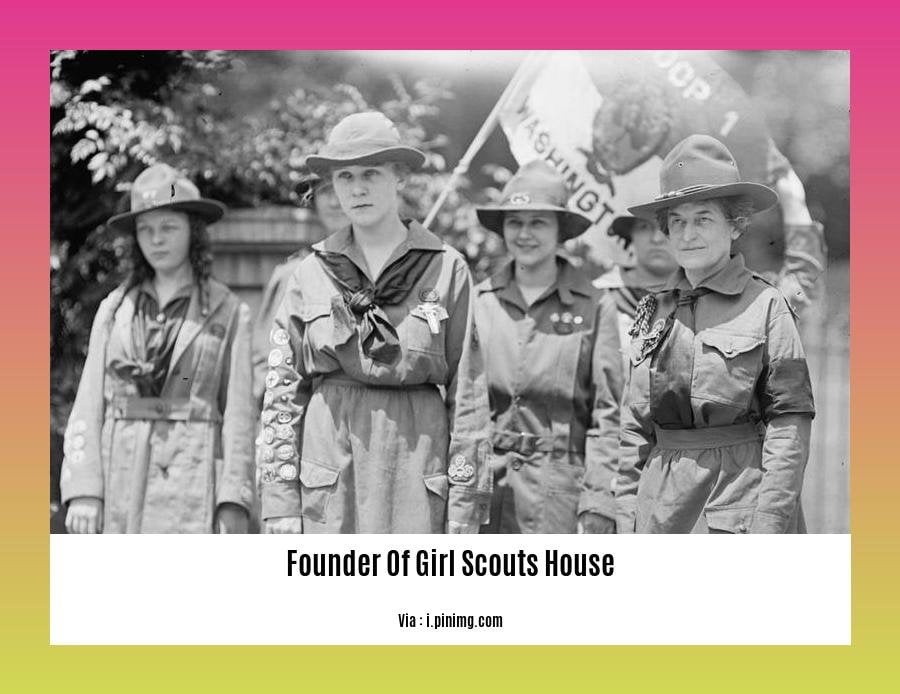Uncover the captivating history of the Boy Scouts, an organization that has shaped youth development for over a century. From its humble beginnings to its profound impact on generations, [- The History of Boy Scouts: A Journey Through Time] delves into the founding principles, challenges, and enduring legacy of this iconic movement.
Key Takeaways:
- Founded in 1908 by Robert Baden-Powell in England as the Boy Scouts Association.
- Initially for boys aged 11-15, expanded to include younger and older boys (Wolf Cubs and Rover Scouts).
- Promotes character development, leadership skills, and outdoor activities.
- Established the Boy Scouts of America (BSA) in 1910.
- Reached millions of members globally by the 1920s.
History Of Boy Scouts
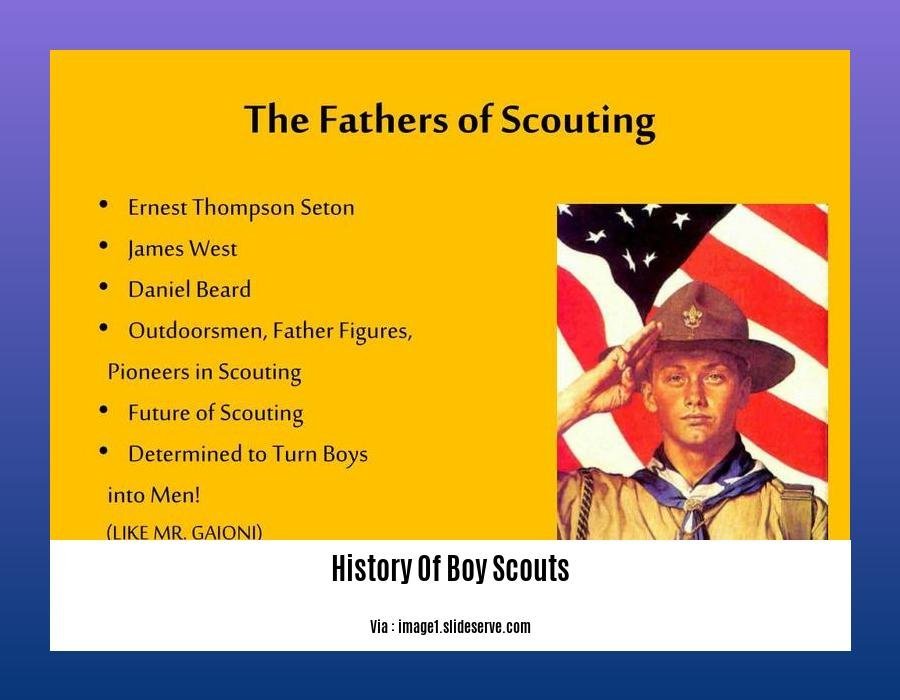
The History Of Boy Scouts can be traced back to the early 20th century. In 1908, a British army officer named Robert Baden-Powell founded the Boy Scouts Association. Baden-Powell believed that young boys could benefit from learning outdoor skills, developing leadership qualities, and serving their communities. The Boy Scouts movement quickly spread to other countries, including the United States. In 1910, the Boy Scouts of America (BSA) was founded.
The BSA has played a major role in the lives of millions of American boys. Over the years, the BSA has helped to shape the character of young men and prepare them for leadership roles in society. The BSA has also been a leader in promoting outdoor activities and environmental stewardship.
Today, the BSA continues to be a vibrant organization with over 2 million members. The BSA offers a variety of programs for boys of all ages, including Cub Scouts, Boy Scouts, and Venturing. The BSA also offers a variety of programs for adult leaders, including training and support. The BSA is committed to providing a safe and fun environment for boys to learn and grow.
Key Milestones in the History Of Boy Scouts
- 1908: Robert Baden-Powell founds the Boy Scouts Association in England.
- 1910: The Boy Scouts of America (BSA) is founded.
- 1916: The Wolf Cubs program is launched for younger boys.
- 1918: The Rover Scouts program is launched for older boys.
- 1920s: The BSA expands globally, reaching millions of members.
- 1930s: The BSA plays a major role in the Great Depression and World War II.
- 1950s-1960s: The BSA experiences rapid growth during the post-war era.
- 1970s-1980s: The BSA faces challenges related to social change and declining membership.
- 1990s-Present: The BSA adapts to a changing world and continues to provide a valuable experience for boys.
Embark on a historical expedition of the iconic Girl Scouts movement by exploring its fascinating origins. Discover the captivating story of the movement’s History Of Girl Scouts, the inspiring journey of the History Of Girl Scouts Of America, and the sweet saga of the History Of Girl Scouts Cookies. Travel across borders to learn about the History Of Girl Scouts In France and the History Of Girl Scouts Of The Philippines. Pay homage to the remarkable Founder Of Girl Scouts, including the inspiring story of the Founder Of Girl Scouts Deaf. Trace the movement’s roots in the Origin Of Girl Scouts and step inside the Founder Of Girl Scouts House for a glimpse into its legacy.
Challenges and Controversies
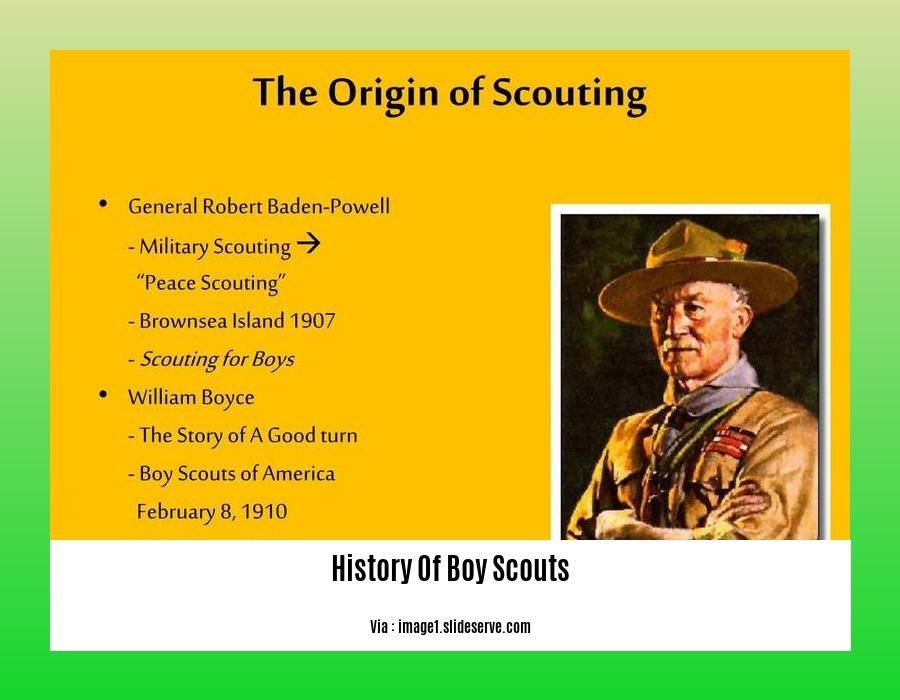
Despite its long and distinguished history, the Boy Scouts have faced numerous challenges and controversies throughout their existence. Some of the most significant include:
Exclusionary Policies: For much of its history, the Boy Scouts maintained strict gender and sexual orientation requirements, excluding women, girls, and LGBTQ individuals. This led to protests, lawsuits, and ultimately, changes in policy.
Sexual Abuse Allegations: The Boy Scouts have been plagued by allegations of sexual abuse within their organization. These allegations have resulted in lawsuits, settlements, and calls for reforms to prevent future abuse.
Decline in Membership: In recent years, the Boy Scouts have experienced a decline in membership. This is due to a variety of factors, including changing social norms, competition from other youth organizations, and ongoing controversies.
Key Takeaways:
- The Boy Scouts have faced significant challenges and controversies over their history.
- Exclusionary policies and sexual abuse allegations have been major sources of controversy.
- The organization has responded to these challenges by changing policies and implementing reforms.
Sources
Boy Scouts – Formation and Influences
What history tells us about Boy Scouts and inclusion
Leadership and Governance
At the heart of the Boy Scouts movement lies a profound commitment to fostering leadership and developing sound principles in youth. Since its inception in 1910, the Boy Scouts of America (BSA) has embraced a unique approach to youth development, grounding it in the pillars of leadership and governance. Within the organization’s structure and programs, young people are actively encouraged to take on leadership roles, developing their skills and contributing to their communities.
The Governance structure of the BSA is designed to provide guidance, oversight, and support to its youth members. A dedicated team of adult volunteers governs the organization, drawing from a wide range of expertise to ensure that the BSA remains true to its mission and values. These leaders are committed to fostering an environment where youth can thrive and grow into responsible citizens, capable of making meaningful contributions to society.
Key Takeaways:
- Boy Scouts of America emphasizes leadership and governance in youth development.
- Youth members actively assume leadership roles within the organization’s structure and programs.
- Adult volunteers provide guidance, oversight, and support as part of the BSA’s governance structure.
- The BSA’s governance ensures the organization remains true to its mission and values, fostering an environment for youth growth and success.
Relevant Sources:
- Boy Scouts of America: About Us
- World Organization of the Scout Movement: Our History
Legacy and Impact
For over a century, the Boy Scouts movement has left an enduring legacy on society. Its commitment to youth development and community involvement has shaped generations of young people.
From its humble beginnings on Brownsea Island, the Boy Scouts movement has expanded globally, empowering young people with leadership skills, outdoor proficiency, and a sense of responsibility. The movement’s impact is evident in the countless individuals it has educated, the communities it has served, and the values it has instilled in young minds.
Think about it. How many successful leaders, scientists, and community activists got their start in Boy Scouts? The organization’s unwavering support for character development and personal growth has helped mold these individuals into the pillars of our society.
Key Takeaways:
- Boy Scouts has a long history of youth development and community involvement.
- The movement has shaped generations of young people through leadership skills, outdoor proficiency, and responsibility.
- The Boy Scouts movement has a global reach and a positive impact on society.
Sources:
- Scouting’s History | WOSM – World Organization of the Scout Movement
- A Brief History and Timeline of Scouting⚜️ – ScoutSmarts
FAQ
Q1. When and where was the Boy Scouts movement founded?
Q2. Who is the founder of the Boy Scouts?
Q3. What were the original age ranges for Boy Scouts?
Q4. What is the name of the parallel organization for younger boys founded in 1916?
Q5. Which US President has not served as an honorary BSA president?
- HelpCare Plus: Revolutionizing Affordable and Accessible Healthcare - December 29, 2024
- Boom & Bucket: Your Digital Marketplace for Used Heavy Equipment - December 28, 2024
- Ankle Bones Crossword Clue: Solutions, Tips & Anatomical Insights - December 28, 2024
